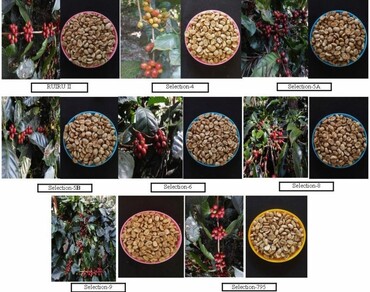Diversity of nutritional compositions in selected coffee varieties from Koraput regions of Eastern Ghats
Research Articles | Published: 09 October, 2024
First Page: 2360
Last Page: 2368
Views: 1681
Keywords: Antioxidants, Food value, Coffee, Nutritional profiling, Caffeine
Abstract
Coffee is an important indigenous beverage of India and its chemical compositions and nutraceutical value is unexplored. The current investigation was to assess the phytochemical composition in 13 local coffee varieties from Koraput valley. Significant differences were observed in the proximate compositions: the average moisture content was 3.36 g/100 g, the protein content was 9.18 g/100 g, the carbohydrate content was 23.48 g/100 g, and the food energy was 247.87 kcal/100 g among the studied coffee varieties. Across all kinds, coffee beans are high in flavonoids (6.53 to 19.08 µg/g), phenol (21.64 to 46.70 mg/g), antioxidants (57.63 to 77.66%), and caffeine (2.41 to 3.85 g/100 g). The initial two principal components recorded 62.2% of the total variations. Based on the results, two coffee varieties such as Chandragiri and Cauvery, are notably high in fiber, protein, energy and antioxidants and are the most nutritious in the area. These varieties can be used in crop improvement programs to enhance quality characteristics. Furthermore, these varieties demonstrated significant potential for creating valuable functional foods.

References
Ahmed GM, El-Ghamery HE, Samy MF (2013) Effect of green and degree of roasted Arabic coffee on hyperlipidemia and antioxidant status in diabetic rats. Adv J Food Sci Technol 5(5):619–626
Al Doghaither H, Al-Malki E (2017) The addition of herbal additives influences the antioxidant activity of traditional Arabic coffee. World Appl Sci J 35(3):393–398
Al-Abdulkader AM, Al-Namazi AA, AlTurki TA, Al-Khuraish MM, Al-Dakhil AI (2018) Optimizing coffee cultivation and its impact on economic growth and export earnings of the producing countries: the case of Saudi Arabia. Saudi J Biol Sci 25(4):776–782
Butt MS, Sultan MT (2011) Coffee and its consumption: benefits and risks. Crit Rev Food Sci Nutr 51(4):363373
Ciaramelli C, Palmioli A, Airoldi C (2019) Coffee variety, origin and extraction procedure: implications for coffee beneficial effects on human health. Food Chem 278:47–55
Erskine E, Gültekin Suba B, Vahapoglu B, Capanoglu E (2022) Coffee phenolics and their interaction with other food phenolics: antagonistic and synergistic effects. ACS Omega 7:1595–1601
Farah A (2018) Nutritional and health effects of coffee. Federal University of Rio de Janeiro, Brazil, pp 1–5
Hagerman A, Muller L, Makkar H (2000) Quantification of tannins in tree foliage: a laboratory manual. FAO/IAEA, Vienna, pp 4–7
Król K, Gantner M, Tatarak A, Hallmann E (2020) The content of polyphenols in coffee beans as roasting, origin and storage effect. Eur Food Res Technol 246:33–39
Mbanjo EGN, Kretzschmar T, Jones H, Ereful N, Blanchard C, Boyd LA, Sreenivasulu N (2020) The genetic basis and nutritional benefits of pigmented rice grain. Front Genet 11:215–229
Munyendo LM, Njoroge DM, Owaga EE, Mugendi B (2021) Coffee phytochemicals and post-harvest handling-a complex and delicate balance. J Food Compos Anal 102:103995
Mussatto SI, Ballesteros LF, Martins S, Teixeira JA (2011) Extraction of antioxidant phenolic compounds from spent coffee grounds. Sep Purif Technol 83:173–179
Núñez N, Saurina J, Núñez O (2021) Non-targeted HPLC-FLD fingerprinting for the detection and quantitation of adulterated coffee samples by chemometrics. Food Cont 124:107912
Padhan B, Biswas M, Panda D (2020) Nutritional, anti-nutritional and physico-functional properties of wild edible yam (dioscorea spp.) tubers from koraput, india. Food Biosci 34:100527
Panda D, Panda A, Prajapati H, Behera PK, Nayak JK, Lenka KC, Parida PK (2023) Genetic variability of panicle architecture and nutritional parameters in indigenous finger millet genotypes from Koraput, Eastern Ghats of India. Cereal Res Commun 51:1015–1029
Panda D, Muni P, Panda A, Lenka KC, Parida PK (2024) Nutritional and nutraceutical richness of neglected little millet genotypes from Eastern Ghats of India: implications for breeding and food value. Planta 259:37
Patay ÉB, Bencsik T, Papp N (2016) Phytochemical overview and medicinal importance of Coffea species from the past until now. Asian Pac J Trop Med 9(12):1127–1135
Saimaiti A, Zhou DD, Li J, Xiong RG, Gan RY, Huang SY, Shang A, Zhao CN, Li HY, Li HB (2022) Dietarysources, health benefits, and risks of caffeine. Crit Rev Food Sci Nutr 62:1–19
Solomakou N, Loukri A, Tsafrakidou P, Michaelidou AM, Mourtzinos I, Goula AM (2022) Recovery of phenolic compounds from spent coffee grounds through optimized extraction processes. Sustain Chem Pharm 25:100592
Vignoli J, Viegas M, Bassoli D, Benassi M (2014) Roasting process affects differently the bioactive compounds and the antioxidant activity of Arabica and robusta coffees. Food Res Int 61:279–285
Wanyika HN, Gatebe EG, Gitu LM, Ngumba EK, Maritim CW (2010) Determination of caffeine content of tea and instant coffee brands found in the Kenyan market. Afr J Food Sci 4(6):353–358
Wu H, Lu P, Liu Z, Sharifi-Rad J, Suleria HAR (2022) Impact of roasting on the phenolic and volatile compounds in coffee beans. Food Sci Nutr 10:2408–2425
Yamagata K (2018) Do coffee polyphenols have a preventive action on metabolic syndrome associatedendothelial dysfunctions? An assessment of the current evidence. Antioxidants 7(2):26
Author Information
Department of Biodiversity & Conservation of Natural Resources, Central University of Odisha, Koraput, India